Paladins are the warriors that serve the Holy Light. Instead of focusing solely on their physical abilities, they embrace Holy magic to improve their defensive and offensive capabilities. The first order of Paladins (Knights of the Silver Hand) was created after the First War, by Uther Lightbringer himself, to help the common folk. Later Paladins started to specialize in protecting people from all that’s evil – mainly the Scourge (undead) and the Burning Legion (demons).
Paladins have three main specializations. They can wear a shield and boost themselves with protective spells while attracting the enemies’ attacks, heal wounded allies and revive fallen ones, or equip a two-handed weapon and rush straight into the combat, relying mostly on their physical skills.
In Hearthstone, Paladin class is represented by the Uther Lightbringer. Players can also unlock two alternative, cosmetic Paladin Heroes – Lady Liadrin and Arthas Menethil.
Themes and Mechanics
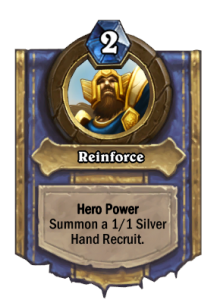 Paladin’s Hero Power is Reinforce. After using it, Paladins summon a 1/1 Silver Hand Recruit minion. The Hero Power is especially powerful against classes that can’t deal one damage easily, so you can create multiple small minions over time and grow your board. It gives Paladin an unending source of minions. They are weak by themselves, but give Paladin a body to buff and synergize with cards like Quartermaster or Lightfused Stegodon.
Paladin’s Hero Power is Reinforce. After using it, Paladins summon a 1/1 Silver Hand Recruit minion. The Hero Power is especially powerful against classes that can’t deal one damage easily, so you can create multiple small minions over time and grow your board. It gives Paladin an unending source of minions. They are weak by themselves, but give Paladin a body to buff and synergize with cards like Quartermaster or Lightfused Stegodon.
Secrets are a mechanic that’s unique to Paladin. While two other classes also have their own Secrets, they’re all significantly different. Paladin’s Secrets are the cheapest ones, they only cost one mana each. It makes them weakest in terms of value, but strongest in terms of tempo. The only exception is Getaway Kodo, which is a purely value card, but can often be played around by pinging a Silver Hand Recruit.
A Paladin build based around Secrets dominated the meta for some time, though it’s still rather popular in the Wild. Secret Paladin was really strong thanks to the insane tempo Mysterious Challenger provided. In Standard, Secrets aren’t actually put into decks, but they still see quite a lot of play thanks to Hydrologist – with the Discover mechanic, Paladin is able to pick the right Secret for the situation. It makes even the worst Secret – Eye for an Eye – situationally useful (e.g. against a Mage with Ice Block).
Learn more about Paladin in World of Warcraft via Wowhead’s class guides: Holy Paladin Guide, Protection Paladin Guide, or the Retribution Paladin Guide!
There are also some ongoing themes when it comes to the Paladin cards. When new cards are released, there is a significant chance that some of them will fall into one of those categories:
- Silver Hand Recruits – Paladin’s Hero Power is probably the most synergistic one in the entire game (maybe next to the Shaman’s Totemic Call). The minions it summons, Silver Hand Recruits, can not only be summoned through the other cards, but also interacted with in many ways. Most of the time, the synergies revolve around buffs – Attack (Warhorse Trainer), Attack + Health (Quartermaster), Taunt (Level Up!) or Adapt (Lightfused Stegodon). The only “unique” synergy right now is Crystal Lion, which gets discounted the more Recruits you have on the board.
- Buffs – Paladin is known for the ability to buff the minions. Pretty much every expansion, the class is getting some new buffs. Even The Last Kaleidosaur Quest is based around buffing. While most of the buffs aren’t commonly played, because they’re risky (if opponent kills a buffed minion with one spell, then you’re down a card), some of them have become Paladin staples. For example, Blessing of Kings is one of the most iconic spells, played in multiple Paladin decks throughout the history, while Spikeridged Steed has become one of the strongest cards from the Journey to Un’Goro expansion. Also, “handbuffs” are a variation on “buffs” theme. Those are the cards that buff cards, but in the hand instead of on the board. While there are some Neutral options, Paladin is THE handbuff class, with both AoE buffs like Smuggler's Run and single target buffs like Val'anyr.
- Healing – Paladins are known for healing cards. While they aren’t the only class that can heal, they have a highest number of healing cards in the game. Some of the most common Paladin healing cards are: Forbidden Healing, Lay on Hands, Ivory Knight, Wickerflame Burnbristle and Ragnaros, Lightlord.
- Murlocs – Murlocs are the Paladin’s main tribe. While it doesn’t make a lot of sense lore-wise, Paladins constantly get new Murloc minions and other Murloc synergies. When we’re talking about minion-based decks, the card that holds the whole Murloc Paladin synergy together is Vilefin Inquisitor, which turns the Silver Hand Recruits (Hero Power 1/1’s) into Murlocs. There was also a combo deck based around Anyfin Can Happen summoning multiple Bluegill Warriors and Murloc Warleaders, but it’s out of Standard already.
- Stat Manipulation – Instead of a classic removal like “deal X damage” or “destroy a minion”, Paladins get to play around with stat manipulation. Paladins can handle big minions by reducing their attack down to one (Aldor Peacekeeper), health down to one (Equality) or just turning them into 3/3’s (Sunkeeper Tarim). The last one can also be used to buff Paladin’s own small minions. Stat Manipulation is mostly used as a removal, but sometimes its main use is to buff own minions, like with Dinosize.
- Divine Shield – While the Divine Shield mechanic is neutral, only Paladin has multiple class cards that revolve around it. Paladins have minions with Divine Shield (Tirion Fordring), ways to give Divine Shield to a minion (Argent Protector) and even a card that synergizes with them (Rallying Blade). Knights of the Frozen Throne pushed the theme even further by introducing further Divine Shield synergies. Some cards get extra effects when a Shield is popped – so far we’ve got a minion (Bolvar, Fireblood) and a weapon (Light's Sorrow) gaining extra Attack.
Strengths and Weaknesses
Strengths: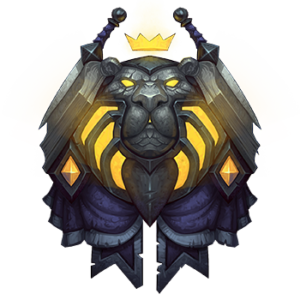
- Healing – Paladins have access to some of the best life gain cards in the whole game. The best thing is that most of their healing cards do something else besides healing, making those cards great in nearly every matchup. For example, Lay on Hands can be used as a card draw even if there’s no need to heal anything, while Ragnaros, Lightlord comes with a big 8/8 body that has to be answered anyway. The only common card that does nothing other than healing is Forbidden Healing, but since it can make up a massive amount of health, it can be forgiven.
- Board Wipes – Equality is one of the best removal cards in the entire game. While it needs to be combined with something else to really work, these combos are still incredible. The two most common ones that are used in Paladin ever since the Classic are Equality + Consecration and Wild Pyromancer + Equality. The first one is a 6 mana board clear that clears only the opponent’s side. It leaves the Paladin’s minions at one health too, but it means that the opponent has to spend another removal to get rid of them. The second one might be even better – it’s a full board clear for just 4 mana. Even though it affects both players and it’s a two card combo, unlike most of the other AoEs, it can save your skin as soon as Turn 4 even against the big boards.
- Great Late Game – Paladins are masters of the late game. No matter if we’re talking about Aggro, Midrange or Control Paladin decks, they have superior late game when compared to the most of the other decks in the same category. Aggro Paladin doesn’t run out of steam that quickly thanks to Divine Favor, while the synergies in Murloc Paladin make up for the lack of expensive cards. Midrange Paladin runs a lot of mid/late game threats and high value cards. Control Paladin has even more board clears, value cards and often runs N'Zoth, The Corruptor as a big finisher to bring all of the dead Deathrattle minions back. Pretty much no other class can match Paladin in terms of the late game value and power.
Weaknesses:
- Requires Minions on the Board – While it’s not true for every Paladin list, as Control Paladin can also fight from behind, most of the Paladin decks are pretty proactive. Any Paladin deck that runs buff cards simply needs minions to cast those buffs on. While yes, it’s possible to play a minion and buff it on the same turn, it’s often risky, as the minion might get removed right away and not get any immediate value. Paladin can also Hero Power and buff it on the same turn, but that’s really slow. E.g. Hero Power + Blessing of Kings is a 6 mana 5/5, which is really not good. At the same time, any Paladin deck that runs multiple Murlocs also wants to play proactively. Murloc synergies are good only with multiple other Murlocs on the board, so one of the best counters would be constantly removing the Murlocs from the board so Paladin can’t stack multiple of them at the same time.
- Weak Early Game – Paladin’s early game is rather weak. The class has almost no strong minions, most of them have low stats and an effect that’s not necessarily that good during the first turns when you want to play on the curve (e.g. Hydrologist or Aldor Peacekeeper). That’s one of the reasons why Murloc decks have gained a lot of popularity and even slower decks have started to use them – gaps in the Paladin’s early game can be more or less filled with the Neutral Murloc options. Similarly, Aggro Paladin decks are mostly using the Neutral minions to keep up while cheating out the tempo and value with Call to Arms and Divine Favor.
- No Burn/Reach – Paladins have always been known for their lack of ways to close out games. Even though they can pack a lot of late game value into their deck, without any sort of burn, even in games where they outvalue the opponent heavily can drag for many more turns. Paladins can rarely deal a lot of burst damage from their hand – weapons and Neutral Charge minions are usually as much as you can expect from them. Sometimes it doesn’t matter, as it will only take a while longer to finish the game, but it’s very problematic when playing against combo decks, where you need to win really fast. It also means that a good player will know to prioritize tempo plays over life gain against Paladin, as there’s not much threat of dying even when at low health.
Meta Decks and Strategies
Here are the Paladin decks you can use on the ladder in the current meta. While not every deck listed here is high tier, they all should be viable options, especially to climb through the lower ranks.
The archetype of Aggro Paladin has been around since the Vanilla days of Hearthstone. The sheer amount of cheap attack-based buffs and minions combined with Divine Favor for refilling your hand provides enough power to overwhelm even the strongest control decks.
Prince Keleseth and a bunch of other additions after the release of Knights of the Frozen Throne brought Aggro Paladin back on the table; but this Kobolds and Catacombs version of Aggro Paladin works perfectly without the Blood Council brother, mostly due to one new card: Call to Arms.
As it is with most aggressive decks, the motto of this deck couldn’t be more simple: Go face when you can. And it really has to be the motto, just because it represents the main win condition of this version of Aggro Paladin.
With a total of five Kobold and Catacombs cards, this deck received a lot of new tools with Hearthstone’s most recent expansion.
Being more of a meme than anything for the longest time in the history of Hearthstone, Murlocs are now an integral part of the meta-game. The vanilla tribe received heavy reinforcement with the releases of Mean Streets of Gadgetzan and Journey to Un’Goro; especially Paladin’s Hydrologist makes the addition of the standard Murloc package almost mandatory in most decks.
With the reign of control decks in the current meta-game, reliable and fun aggro alternatives are in dire need, and Murloc Aggro Paladin is surely one of them.
In general, the archetype and its win condition doesn’t change with Hearthstone’s newest expansion.
However, the list received a total of six possible new cards to include. Being the most mandatory, Corridor Creeper, the dark horse of Kobolds and Catacombs, seems to be a perfect addition to any aggro deck, and that includes Murloc Paladin. The sheer power level it can create when dropped on early turns is unmatched.
Another star of the expansion is Paladin’s new spell Call to Arms. With almost half of the deck being two- or less-mana drops, this card will always pull out something useful to interact with the board.
Last but not least is Unidentified Maul: The new Paladin weapon that can transform into four different weapon types will bolster your board with effects like Divine Shield or +Attack.
When thinking about the control archetype, Paladin has always been one of the first classes that comes to mind. Cards like Tirion Fordring, Equality, and Aldor Peacekeeper allow Paladin to take huge value turns even when drastically behind on the board.
With Kobolds and Catacombs further increasing the power level of decks in the game, the traditional Control Paladin strategy of outlasting the opponent has become even more difficult. While it is still possible to outlast aggro decks, Paladins are generally unable to answer the powerful win conditions of other control decks through removal and a couple of big threats alone. Arguably, Control Paladin has always lacked an end game to effectively challenge other control decks, but with the traditional lists this is now even more pronounced.
Nonetheless, the archetype has found new ways to survive. Including bigger swing turns is now more important than before, and N'Zoth, The Corruptor can help with that. Alternatively, comboing down your opponent with Auctionmaster Beardo is a fun and at least somewhat viable end game strategy. As for the early game, Call to Arms provides the means to effectively challenge the current aggro decks that are happy to kill your Turn two Doomsayer. The life of Control Paladin is not easy in the Catacombs, but it is still viable.
Budget and Basic Decks
If you’re a new player without a big collection, you might be looking for a way to play Paladin without spending a lot of your Dust on the Legendaries.
A Basic deck is a deck with only the starter cards. Every player can make it after unlocking the class and leveling it up to 10 (which unlocks every Basic card). It’s a best solution if you have just started playing the game – you can test each class without investing into it.
A Budget deck is a cheap deck with no Epics, Legendaries or Adventure cards. Budget decks only run the basic cards + Commons and Rares, which makes them relatively cheap and accessible even for players who have recently started. Average budget deck will cost up to 2,000 Dust to craft, but the number goes down heavily when you own some of the cards already. Even with a relatively small collection, you should be able to build one with just a few hundreds of Dust.
Basic decks are mostly meant for the Casual mode and up to Rank 20 in Ranked. Budget decks can easily be played up to Rank 10 in Ranked, while some of the better ones can even get you up to Rank 5.
This deck is a Midrange Paladin with a slight focus on the token synergies. Tokens are the cards you spawn through extra effects, like Battlecries or – in case of Paladin – your Hero Power. They’re usually small, but also cheap and disposable. While there aren’t many Basic token generators (Razorfen Hunter is pretty much the only decent one), the Hero Power will still make some of the Basic cards more powerful than in the other decks. Two best examples are Frostwolf Warlord and Stormwind Champion. Normally, it might be pretty hard to get more value out of them, however with a Hero Power that spawns 1/1’s, those cards might just win some of the games. Besides that, Paladin is one of the only Basic decks that uses weapons. They’re great in a way that they usually give Paladin a card advantage, but at the same time, they drain the life total much faster than usually.
The Midrange Paladin Basic deck is a bit harder to pilot correctly than a more straightforward deck like Druid. Given that the deck runs many buffs or cards which power depends on the board state, smart trading, controlling the board and utilizing weapons correctly is often the key to win the games, which might be pretty difficult for the new players piloting it. On the other hand, playing this deck might help you learn the basics of the trading, when it’s worth to do it, when it’s better to pass up, how to use life as the resource when playing weapons etc. The deck is more challenging, but can also be more rewarding if played right.
Handbuff Paladin is a relatively new archetype. Whole “handbuff” mechanic was first introduced in the last year’s Mean Streets of Gadgetzan expansion as a part of the Grimy Goons gang. It was generally considered to be worst of the gangs, with the mechanic not being really utilized until a whole expansion later – Journey to Un’Goro. That’s where the first semi-viable Handbuff Paladin list was really created.
Handbuff Paladin is based on two types of cards. First – handbuffs. Cards like Smuggler's Run, which buff every minion in the Paladin’s hand. And second – buff targets. Basically cards that work better with handbuffs – those might be cards that replace themselves in your hand (Fire Fly, Stonehill Defender) or that spawn multiple bodies, each profiting from the buff (Saronite Chain Gang, Doppelgangster).
Handbuff Paladin isn’t a particularly powerful deck. Even though Paladin is doing fine right now, other decks require multiple Epics and Legendaries to work. Which makes Paladin a very weak budget option right now, unless you really want to play the class.
Level-up Rewards
Every two levels, up to level 10, you will get two copies of a Basic class card. A lot of those cards are staples, so it’s heavily advised to highly prioritize getting every class to level 10.
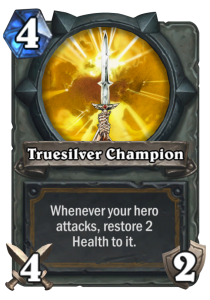 |
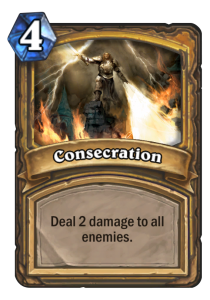 |
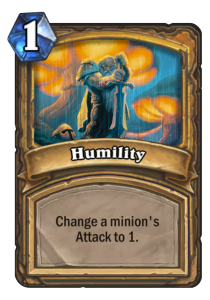 |
| Level 2 | Level 4 | Level 6 |
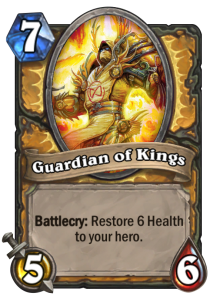 |
 |
| Level 8 | Level 10 |
Every few levels past level 10, you will be rewarded with a Golden version of one of the Basic cards. Leveling up past 10 doesn’t give you any competitive edge – all the rewards are cosmetic.






































































I have to admire the depth you put to these guides, I love them!